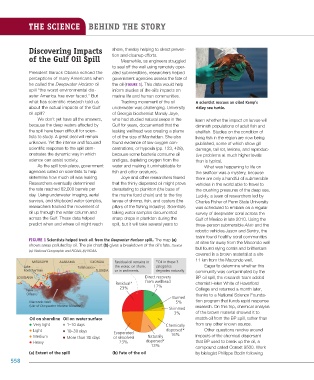Page 559 - Environment: The Science Behind the Stories
P. 559
THE SCIENCE BEHIND THE STORY
Discovering Impacts shore, thereby helping to direct preven-
of the Gulf Oil Spill tion and cleanup efforts.
Meanwhile, as engineers struggled
to seal off the well using remotely oper-
President Barack Obama echoed the ated submersibles, researchers helped
perceptions of many Americans when government agencies assess the fate of
he called the Deepwater Horizon oil the oil (FIGURE 1). This data would help
spill “the worst environmental dis- inform studies of the oil’s impacts on
aster America has ever faced.” But marine life and human communities.
what has scientific research told us Tracking movement of the oil A scientist rescues an oiled Kemp’s
about the actual impacts of the Gulf underwater was challenging. University ridley sea turtle.
oil spill? of Georgia biochemist Mandy Joye,
We don’t yet have all the answers, who had studied natural seeps in the learn whether the impact on larvae will
because the deep waters affected by Gulf for years, documented that the diminish populations of adult fish and
the spill have been difficult for scien- leaking wellhead was creating a plume shellfish. Studies on the condition of
tists to study. A great deal will remain of oil the size of Manhattan. She also living fish in the region are now being
unknown. Yet the intense and focused found evidence of low oxygen con- published, some of which show gill
scientific response to the spill dem- centrations, or hypoxia (pp. 123, 428), damage, tail rot, lesions, and reproduc-
onstrates the dynamic way in which because some bacteria consume oil tive problems at much higher levels
science can assist society. and gas, depleting oxygen from the than is typical.
As the spill took place, government water and making it uninhabitable for What was happening to life on
agencies called on scientists to help fish and other creatures. the seafloor was a mystery, because
determine how much oil was leaking. Joye and other researchers feared there are only a handful of submersible
Researchers eventually determined that the thinly dispersed oil might prove vehicles in the world able to travel to
the rate reached 62,000 barrels per devastating to plankton (the base of the crushing pressures of the deep sea.
day. Using underwater imaging, aerial the marine food chain) and to the tiny Luckily, a team of researchers led by
surveys, and shipboard water samples, larvae of shrimp, fish, and oysters (the Charles Fisher of Penn State University
researchers tracked the movement of pillars of the fishing industry). Scientists was scheduled to embark on a regular
oil up through the water column and taking water samples documented survey of deepwater coral across the
across the Gulf. These data helped sharp drops in plankton during the Gulf of Mexico in late 2010. Using the
predict when and where oil might reach spill, but it will take several years to three-person submersible Alvin and the
robotic vehicles Jason and Sentry, the
team found healthy coral communities
FIGURE 1 Scientists helped track oil from the Deepwater Horizon spill. The map (a) at sites far away from the Macondo well
shows areas polluted by oil. The pie chart (b) gives a breakdown of the oil’s fate. Source but found dying corals and brittlestars
(a): National Geographic and NOAA; (b) NOAA.
covered in a brown material at a site
11 km from the Macondo well.
MISSISSIPPI ALABAMA GEORGIA Residual oil remains in *Oil in these 3
Lake Tallahassee the water, on shore, categories Eager to determine whether this
Pontchartrain FLORIDA or in sediments. degrades naturally community was contaminated by the
LOUISIANA Direct recovery BP oil spill, the research team added
Residual* from wellhead chemist Helen White of Haverford
23% 17% College and returned a month later,
New
Orleans thanks to a National Science Founda-
Burned
Macondo Well 5% tion program that funds rapid response
(site of Deepwater Horizon blowout) research. On this trip, chemical analysis
Skimmed
3% of the brown material showed it to
Oil on shoreline Oil on water surface match oil from the BP spill, rather than
Very light 1–10 days Chemically from any other known source.
Light 10–30 days Evaporated dispersed* Other questions revolve around
Medium More than 30 days or dissolved Naturally 16% impacts of the chemical dispersant
Heavy 23% dispersed* that BP used to break up the oil, a
13% compound called Corexit 9500. Work
(a) Extent of the spill (b) Fate of the oil by biologist Philippe Bodin following
558
M19_WITH7428_05_SE_C19.indd 558 12/12/14 5:23 PM

